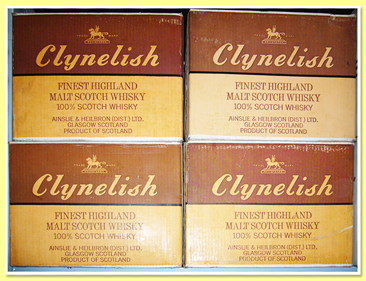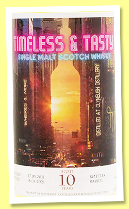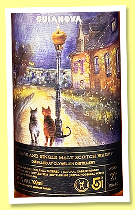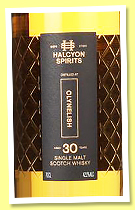| |

Home
Thousands of tastings,
all the music,
all the rambligs
and all the fun
(hopefully!)



Whiskyfun.com
Guaranteed ad-free
copyright 2002-2025
|
 |
|
| Hi, this is one of our (almost) daily tastings. Santé! |
| |
|
| |
| |
January 1, 2025 |
|
  |

|
A small line-up of Clynelish, vertically arranged, to celebrate the New Year |
Without 'Secret Highlands' that might—or might not—be Clynelish. We simply couldn't start the year without a few Clynelish, you see, and without asking ourselves a question that's fundamental for us but probably of little interest to the rest of the world: "Does Brora's relaunch cast a bit of a shadow over Clynelish?" Consider yourselves warned. |

A little glimpse of paradise—Italy, around 2004 (WF Archive) |

|
Clynelish 10 yo 2011/2021 (60.2%, Timeless & Tasty, Whiskies & More, barrel, cask #800313, 234 bottles) 
A bottling from Hong Kong. Colour: straw. Nose: it opens with crushed slate and apple compote before shifting towards grist and husks, evoking a sense of wandering through the distillery itself. With water: damp chalk, bandages, camphor, embrocations and plasticine—the hallmark has arrived. Mouth (neat): these vintages lean heavily towards fruit, but here it’s more about sharp apple and lemon with slightly unusual medicinal notes. However, at this strength, it’s a touch early to draw firm conclusions. With water: pure Clynelish, just lightly mentholated and mildly aniseed. Finish: long, with citrus firmly taking charge. Comments: 1. buy by the case, 2. lay down for 30 years. Deep affection for this profile.
SGP:562 - 88 points. |

|
Clynelish 13 yo 2010/2024 (56.6%, The Single Malts of Scotland Reserve Casks, Elixir Distillers for LMDW, bourbon barrel, cask #800188, 207 bottles) 
Colour: white wine. Nose: it opens with fresh cement and damp chalk, followed by a hint of the seaside not far from the distillery and finishing with green apples and a sort of fruity earthiness. Very little wax at this stage. With water: austere, leaning towards cut grass and even more cement, though the apples have ripened. Mouth (neat): very Clynelish this time, starting with paraffin, then growing salinity and touches of varnish and mustard, increasingly evoking the West Coast—Ben N. style—which is certainly no bad thing. With water: classic Clynelish! A touch of beer, candle wax, mandarin, green pepper and a notably oily texture. Finish: long and oily, with those lovely mandarins and a hint of jasmine tea. Comments: a genuine conversation in your glass. Fascinating and excellent. In the end, it becomes very close to the 2011, which will surprise no one.
SGP:562 - 88 points. |
Let’s jump forward more than 15 years, but we're back around Hong Kong... |

|
Clynelish 27 yo 1997/2024 (47.2%, The Antelope Macau, 5th Anniversary, refill hogshead) 
Very fine vintages when they’re not too influenced by sherry—let’s see what these Aristocats on the label have to offer. Colour: deep gold. Nose: few things can rival the candied citrons found in these Clynelish. Neither the nuts (sherry, naturally), nor the beeswax, nor the fresh fougasse. One bows in reverence… Mouth: what balance! A perfect example of a sherry (I suspect it’s refill sherry) that adds complexity without overshadowing the distillate in the slightest. And what a distillate! Orange zest, pollen, little violet-flavoured sweets, hints of earth, plenty of wax of course, a tiny drop of fine Sauternes, and ever-present citrus, especially simple squeezed orange. I’m absolutely smitten with this one. Finish: long and more earthy, with touches of truffles and morels, along with those marvellous oranges peeled in honey and olive oil that always win universal approval. Black pepper lingers in the aftertaste. Comments: the age is perfect. Hope we’ll keep finding these under the Distillery’s banner.
SGP:651 - 90 points. |

|
Clynelish 30 yo 1993/2023 (42.1%, Halcyon Spirit, casks #11082 + 11104, 154 bottles) 
An intriguing vatting, perhaps done to ‘boost’ a cask that had dropped a little too low in ABV. It’s always fascinating and often sublime in terms of results. Didn’t Springbank often do this back in the day? Colour: pale gold. Nose: it’s remarkable—though perhaps not surprising—how much this leans towards the early 1970s style, with those ripe old apples and, above all, everything that comes from a beehive, starting with beeswax but also pollen, pinewood, honey and propolis. In the background, there’s fresh paint and putty. Watch your fingers (S.!) Mouth: the oak is slightly more present, with black tea and crushed pepper, but the wax and old apples soon reclaim control, accompanied by a touch of turpentine and menthol. The propolis is even more pronounced than on the nose. Finish: medium length, leaning more towards pine needles and, again, propolis. A hint of juniper. Comments: it’s magnificent and at no point do you wish for more watts. It rather calls to mind a very old pianist who still masters Chopin as well as ever—if not better.
SGP:651 - 91 points. |
We’re finishing with this gem, one of the rare 98/100 on WF, but from a different bottle than the ones we’ve already tasted. Any excuse to revisit these things, really... (It was actually a Facebook post that gave me the idea, I swear!) |

|
Clynelish 24 yo (49.4%, Cadenhead, Sestante, +/-1989) 
We’ve never been able to confirm whether this bottle was distilled in 1965 or 1966 (so pre-Brora Brora in any case). That matters because it was in 1965 that Clynelish ceased using its own floor malting. However, there’s no proof that the 1965 Cadenhead’s were still ‘floor malted’, and we don’t know precisely which month in 1965 the distillery switched to sourced malt (probably from Ord). I should add that M. Mainardi of Sestante doesn’t seem to recall this particular bottle, but if this is ‘fake’ Old Clynelish, then the forgers were absolute geniuses—bravo and thank you to them! Colour: amber. Nose: good heavens! We start off in a luxury shoe shop, with sumptuous leathers and polishes, then move to a garage specialising in vintage cars (rare old tools, engine oils, petrol, tyres), followed by an artist’s workshop (linseed oil, paint, canvases, turpentine, varnish) and finally end up at a fruit merchant’s stall brimming with all kinds of citrus. Mouth: we linger at the fruit merchant’s, then wander over to the tea vendor, and finally step into an old church where the pews have just been waxed and the candles replaced (these aromas translate beautifully onto the palate). Beyond that, we’ll let your imagination take over. Finish: an utterly sublime finale, smoky, immensely complex and astonishingly long, with refined coffees and broths at the very end. Truffle broth, Bocuse-style. Comments: amusingly, I’ve just realised we tasted this Old Clynelish before—from another bottle—while celebrating New Year 2015. Of course, we won’t revise our final score despite the ten-year gap.
SGP:563 - 98 points. |
Clynelish is vital for our survival. Dinosaurs didn't have Clynelish and look what happened to them! (Couldn't we stop the silly jokes in 2025, S.?) Speaking of jokes, here’s what a whisky expert—whom we won’t name out of Christian charity—wrote about Clynelish back in the 1990s:
"Sadly, however, it is no longer the Clynelish Distillery. It held this distinction
until 1968 but was superseded by a box-shaped monstrosity which the old Scottish Malt Distillers company considered a worthy replacement. The whisky produced there is, admittedly, pretty fine and highly prized by a number of blenders. But it is not a patch on the original distillery's make, which was fruitier and slightly peatier, perhaps because its water came from a different source."
Sweet Vishnu! |
Indeed, siince everyone seems to be after lists these days, here's a PDF file (in the old Malt-Maniacs style) featuring all the spirits we've rated 92 points or above in 2024:
LIST OF TOP SCORES WF 2024
Naturally, we couldn't resist adding a few scattered statistics and comments below: |
The Scores: |
| 133 tastings received a score of 92 points or higher from Serge or Angus between 1 January and 31 December 2024, out of approximately 1,800 reviews written during the year. |
- 99 points: 0 scores
- 98 points: 0 scores
- 97 points: 0 scores
- 96 points: 1 score
- 95 points: 6 scores
- 94 points: 12 scores
- 93 points: 45 scores
- 92 points: 69 scores
- Less: approx 1,700 scores
|
| |
| Our Two Tasters: |
- Serge: 98 scores of 92 points or higher
- Angus: 35 scores of 92 points or higher
|
| |
| Four Categories: |
- Whisky: 92 scores of 92 points or higher
- Cognac: 15 scores of 92 points or higher
- Rum: 12 scores of 92 points or higher
- Armagnac: 4 scores of 92 points or higher
|
| |
| Recent Bottles vs. Old Bottles: |
- Recent Bottlings (bottled <10 years ago): 73 scores of 92 points or higher
- Older Bottlings (bottled >10 years ago): 60 scores of 92 points or higher
|
| |
| The Top Whisky Distilleries: |
- Port Ellen: 15 scores of 92 points or higher
- Ardbeg: 7 scores of 92 points or higher
- Brora: 6 scores of 92 points or higher
- Bunnahabhain: 5 scores of 92 points or higher
- Caol Ila: 5 scores of 92 points or higher
- Glen Grant: 5 scores of 92 points or higher
- Highland Park: 5 scores of 92 points or higher
- Lagavulin: 5 scores of 92 points or higher
- Springbank: 5 scores of 92 points or higher
- Ben Nevis: 4 scores of 92 points or higher
- Bowmore: 4 scores of 92 points or higher
- Benromach: 3 scores of 92 points or higher
- Macallan: 3 scores of 92 points or higher
|
Moderately significant comments: |
| |
This list depends on what comes our way or what we actively seek out
It is not a precise reflection of the market or the overall quality of spirits, even though we make a point, especially with whiskies and even rums, of tasting a bit of everything. That said, it’s still the top distilleries that tend to appear on this list. |
Expensive Whiskies Dominate the Top of the List
The higher end of the whisky list is generally occupied by whiskies that are currently very expensive—sometimes even outrageously so. At least we can say that these bottles are genuinely rare, and we accept that rarity often commands a high price. Rest assured, however, that very expensive whiskies whose rarity is merely a façade, while their quality remains average or just slightly above, will never make it into this list. Let’s see what the upcoming trend of “de-premiumisation” will bring. |
Excellent Whiskies Scoring 88–91 Points
Keep in mind that many whiskies scoring 88–91 points, which are often fabulous and much more affordable—sometimes around €50—are not, de facto, included in this list. |
Older Bottlings Continue to Impress
After 22 years of Whiskyfun, we’re still coming across older bottlings that we’ve never tasted before and that absolutely blow us away. We couldn’t be happier about that! |
Notable Trends Among Distilleries
Many big names only appear on this list thanks to older bottlings (e.g., Ardbeg, Macallan, Bowmore, Laphroaig, Glen Grant). We hope to see this balance shift in the future. Some distilleries maintain their rankings through a combination of recent and older releases, such as Highland Park, Bunnahabhain, Lagavulin, and Springbank—kudos to them! |
Emerging Stars
New “blue chip” distilleries are emerging, like Benromach and Ben Nevis, which seem to have made significant progress in the past few decades. |
Closed Distilleries Hold Their Status
Prestigious closed distilleries continue to hold their ground, and we eagerly await the return of younger whiskies from the new or renewed Rosebank, Brora, and Port Ellen. |
The Absence of Clynelish
Clynelish is notably absent, largely due to the lack of new releases under the original distillery’s name—an unfortunate situation. It is also true that we had already tasted almost all of the older bottlings before 2024. |
New Distilleries Show Promise
New Scottish and Irish distilleries aren’t quite at this level yet, but that’s to be expected. We’ll likely see them make their mark within the next ten years (e.g., Ardnahoe, Ardnamurchan, Isle of Harris, and others). |
Whiskies from Newer Regions
Whiskies from newer whisky-producing countries are getting closer to inclusion. Hellyers Road is already on the list, and we anticipate others will follow in the coming years—such as Millstone, Smögen, Cotswolds, hopefully Waterford, as well as some smaller American, Nordic, French, and German distilleries. I'm sure I'm missing other countries. |
Japanese Whiskies
Japan is well-represented with Yoichi and Chichibu. We’re expecting others, like Shizuoka, to join soon. Other big names, such as Yamazaki and Miyagikyo, remain very close. |
Outstanding Rums
Several rums have impressed us, particularly Enmores and some TDL from Trinidad. Other distilleries are producing massive numbers of different sublime rums (scoring 89–91) that are likely to make it onto this list soon—names like Hampden, Bielle, and others. Other productions remain pretty poor though, especially some 'new brands'. |
Exceptional Cognacs and Armagnacs
There’s a respectable number of cognacs and armagnacs featured, but this isn’t fully representative since we tend to receive or retrieve only the very best examples—and even then, not all of them. Unlike with whiskies and rums, we rarely taste the more everyday offerings in these categories. Life is short and precious. |
| |
Aside from that, and more generally:
We won’t harp on about it, but the use of alien casks—and the “Doritos strategy”—is becoming even more widespread, as most second-hand wine casks are really quite inexpensive. It is worth noting that some distilleries now focus almost exclusively on finishings—whether in red wine casks, mizunara, STR casks, or just about anything else you can think of. Increasingly, and unlike what happens in other categories such as cognac, whisky producers are clearly prioritising age statements first using ‘any lazy casks’ and then just flavouring their distillates before releasing them. Unfortunately, we’re starting to see this trend appear in rum as well… I must admit we’re getting tired of receiving press releases announcing a so-called world-changing innovation—a new expression finished in mizunara! Wow! |
The waves of new distilleries continue—but the tide keeps going out
I believe that quality will be the key during these times of low tide. The numbers were alarming in 2024, but we won’t repeat or analyse them as everyone else has already done, sometimes in a rather sardonic way—we’ve seen a lot of schadenfreude. You can count on us to support, within our modest means, those who choose to focus on quality. That said, some younger producers who highlight their ethical, local and environmentally friendly approaches (as they all seem to do, to be fair) will need to align their actions with their claims. |
By the way
There are some new, highly "branded" names, like SirDavis or Eminente, which aren’t as bad in tasting as whisky geeks had feared. This marks a change from just three years ago, when many believed that only branding, packaging, and cheap storytelling mattered. Who knows—Beyoncé’s whisky might not turn out to be just a buy-once bottle after all (S., you’ve outdone yourself once again!) I even think we’ll end up tasting SirDavis in 2025—just imagine that! |
| |
|
| Okay, good... |
| A few words about the market, from my very modest point of view (I just couldn’t resist). I wrote 99% of this quite a few weeks ago and had never published it—perhaps I should have stuck with that decision after all. Read only if you must, |
| Indeed social media, forums, blogs, vlogs, and podcasts are brimming with discussions about the state of the whisky market, and spirits in general, especially since the Scotch Whisky Association released its latest figures (exports for the first half of 2024: -18% in value, -10% in volume compared to the first half of 2023, which also indicates price pressures). It's even worse if you take the first nine months into account - in fact, we do not want to know. . |
| The situation varies across different markets, and commentators offer a range of reasons, including: post-Covid effects, inflationary spirals leading to a slowdown, a shift towards frugality, the fragility of formerly emerging markets, trends towards modesty, global anxiety, excessive premiumisation, declining alcohol consumption among younger people, the rise of alternative substances which supposedly 'make you lose weight rather than gain it' - or so I’ve even heard, health concerns, a demand for transparency on environmental impact, rejection of greenwashing, the weariness of certain concepts and market positions, over-industrialisation, short-termism, increasing blending/finishing with other wines and spirits (bastardisation of the product), local markets favouring regional offerings, a highly fragmented supply, unrestrained branding but globally identical brand visions, homogenisation of styles leading to the loss of what used to make brands and distilleries distinctive, growing power of the secondary market, the fetishisation of old bottles by enthusiasts (buffered market), loss of qualitative markers (an age statement can’t be replaced by a faux crystal decanter), proliferation of product references, and the natural long and medium-term cycles inherent to the category, to name but a few. Enough already! |
| Was this predictable, did we see it coming? We can always say yes, of course, and claim that people had been talking about a “bubble burst” for years, but hindsight makes everyone a genius. Now it’s true that we had already talked about all this here on 1st January 2024—how we wish we had been wrong! In any case, it seems to me that, over the long term and in broad strokes, the phases of all this could be outlined as follows. Bear in mind, this is really just a rough, quick, and highly personal take on the so-called “ages” that the industry itself has highlighted (especially the Age of Innocence, of course): |
| Our Five Ages of malt whisky: |
- Age of Ignorance until 1985 (tourist interest, cultural appeal, casual consumption).
- Age of Evidence until 1995 (single malts are great!).
- Age of Innocence until 2010 (you can buy anything you want for not much money! Thanks, Internet).
- Age of Arrogance until 2023 (including Covid). Please note that Angus doesn't quite agree with this term (smile). Premiumisation, organised scarcity, overbranding. The rising tide lifts all boats.
- Age of Abundance until 2???. Multiplication and diversification of supply, overcapacity, new loch, reorganisation, further loss of brand loyalty, cheaper prices, better quality, newcomers shaking up or even overtaking the established players, back to core values.
|
| Keys, I think: education, reasonable transparency, authenticity, proven quality, product over branding, new trust. |
| Let’s hope this is not just wishful thinking. |
| We've been too long again. |
| Happy New Year, hugs and peace! |
 |
|
|
| |
|
|
|
|
|
|

